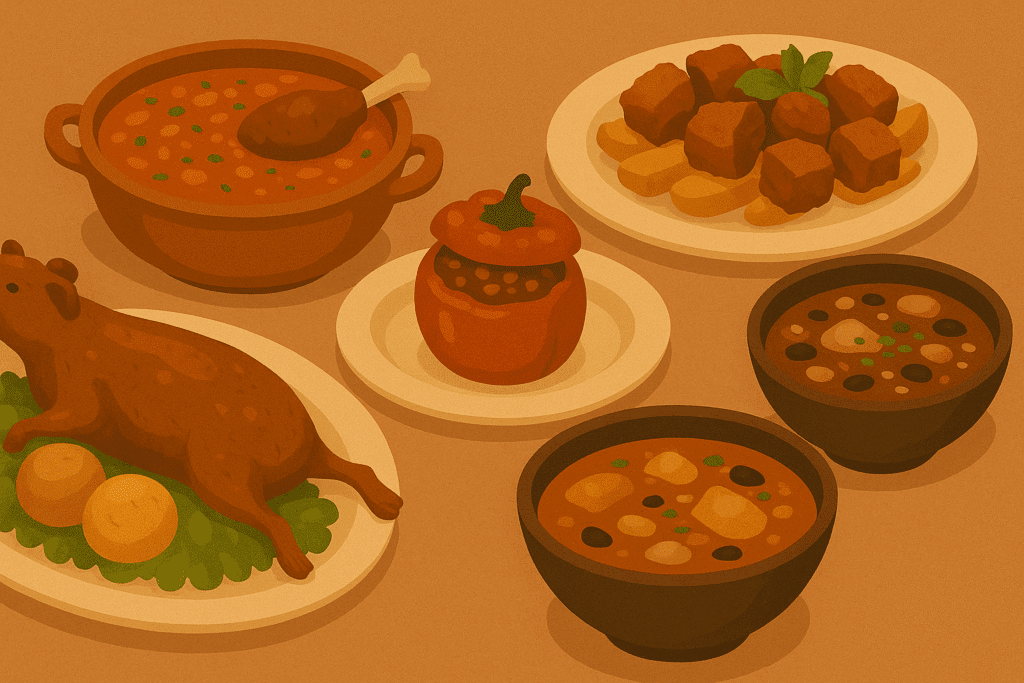Paw Bramble is one of those dishes that defy simple labels. Is it a stew? A warm salad? A Creole hangover remedy? This recipe, based on boiled pig's feet, pickled onions, and chili peppers, has a history as rich as its flavor. Although it did not originate in Cusco, it is now a staple of the city's markets, fondas, and popular celebrations.
Bramble or Zarza in Spanish is an old term that refers to dishes where cooked ingredients are mixed with onion, vinegar, chili and herbs, much like a creole salad. Patitas refers to pig's feet, cooked for several hours until tender and gelatinous. They are used in pieces or boneless.
The result is a warm or cold dish, full of flavor, collagen and tradition, perfect for popular lunches, post-celebration breakfasts or simply to comfort the body.
📜History
Although it is usually found in Cusco markets as a local classic, the paw bramble is not originally from Cusco. This dish comes from the popular Creole cuisine, especially from regions such as:
- Traditional Lima (Barrios Altos, Rímac)
- Arequipa, with its spicy version
- Mantaro Valley (Huancayo, Ayacucho)
This dish began to gain popularity in Cusco during the twentieth century, thanks to the movement of migrants, interregional trade, and the spread of Creole dishes in Andean cities. In Cusco, the dish was adapted to local tastes with less vinegar and yellow chili pepper instead of rocoto. It is almost always served with boiled potatoes.
🤔 Curiosities of the Paw Bramble.
- The paw paw bramble is considered by many to be a “death lifter”, ideal for relieving hangovers.
- Formerly it was prepared in times of austerity, taking advantage of less commercial parts of the pig.
- In rural Cusco, some cooks add red chili pepper or panca chili to the dish, which adds color and depth.
🔬 Nutritional Value of Paw Bramble
- 16 to 18 g of protein per 100 g (with low biological value).
- High fat content (16 to 18 g), mostly saturated, so it should be consumed in moderation.
- B complex vitamins, especially B2, B3 and B6, essential for energy metabolism.
- Small amounts of iron and zinc, useful for cell regeneration.
They contain no carbohydrates and are low in sodium when cooked without added salt. Overall, they are a nutritious food, but they are not suitable for frequent consumption by people with high cholesterol or cardiovascular disease.
📍 Culture Importance in Cusco
In the city of Cusco, the paw bramble has earned a special place as one of the most popular and popular:
- Popular dish in markets such as San Pedro, Wanchaq and San Jerónimo
- Common option in patron saint festivals such as San Sebastián
- Revitalizing food in post-holiday breakfasts
- Canteen or fonda food, ideal to accompany with chicha or beer. chicha o cerveza
Although it is not an ancestral Andean dish, it represents the fusion between coastal Creole cuisine and the Andean palate, adapted to local tastes.
📌 Ingredients
This dish needs time, patience and love, like any good tradition.
| 🛒 Ingredients | 📌 Quantity for 4 diners. |
|---|---|
| pig's feet | 4 |
| Onion | 1 |
| yellow chili pepper | 1 |
| white potato | 8 |
| Salt and pepper | to taste |
| Lemon | 2 |
| Vinegar | a small jet |
| Parsley | Chopped |
🍲 Preparation
- Boil the pig's feet for two to three hours until they are very tender. Then, cool and cut them into small pieces or debone them.
- In a large bowl, mix the onion, chili, salt, pepper, lemon, vinegar and mint. Let stand for 10 minutes.
- Add the cooked legs and mix gently.
Serve over boiled potatoes, with hominy or lettuce if desired. Can be served warm or cold.
👨🍳👩🍳 Regional Variants of Paw Bramble
- Lima Criolla: Plus vinegar and onion, no potato. Served as a starter
- Arequipa: Use of rocoto and huacatay. More spicy
- Ayacucho / Huancayo: It is accompanied with mote and aji colorado (red hot bell pepper).
- Versión moderna: Served boneless, in sandwiches or as a gourmet appetizer.
✨ Conclusion
The paw bramble is a symbol of popular creativity, representing those recipes born from ingenuity in the face of necessity that become local delicacies. In Cusco, the cuisine has embraced it: it has been adapted, celebrated, and served time and again at humble tables and lively celebrations.
If you visit a traditional market in Cusco, do not hesitate to try it: cold or warm, it will always be a surprise that combines flavor, texture, history and Peruvian seasoning in every bite.





